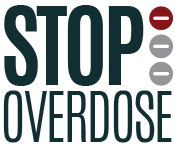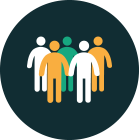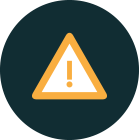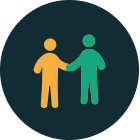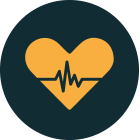You are here
Stop Overdose
Instructions for Using NARCAN® Nasal Spray 4mg
- Call 911 and administer naloxone
- Do rescue breathing or chest compressions. Follow 911 dispatcher directions
- Remain onsite until assistance arrives and cooperate with first responders. The Good Samaritan Law protects you so you can protect your friend.
What is naloxone?
Naloxone is a prescription medication that temporarily reverses an opioid overdose. Sold under the brandname Narcan® or Evzio®, the medication can be given by intranasal spray or auto-injector.
How does naloxone work?
Naloxone is an antidote to overdose of heroin or other opioid drugs. It works by blocking the effects of opioids in a person’s system, helping to restore breathing.
Is it safe?
Naloxone has no potential for abuse or addiction. It is safe, effective and approved by the FDA. However, this lifesaving effect is temporary. Overdose always requires immediate medical attention.
How long does naloxone take to work?
Naloxone acts in 2-5 minutes. If the person doesn’t wake up in five minutes, a second dose of naloxone may be provided.
Can naloxone cause harm?
Naloxone is safe to give someone you suspect is experiencing an opioid overdose. People who are given naloxone during an opioid overdose may wake up and go into withdrawal. Although withdrawal is unpleasant – it is not life-threatening. Naloxone has no effect on a person that has not used heroin or other opioids.
How long does naloxone last after being given?
The effect of naloxone is temporary. Once naloxone wears off, the person may return to an overdose state and is at risk for death. Overdose always requires immediate medical attention.
Who can get a prescription?
North Dakota law allows anyone at risk for having or witnessing an opioid overdose to obtain a prescription. (North Dakota Century code 23-01-42)
Where do I get naloxone?
A physician or local pharmacists can write a prescription to anyone for naloxone. Most private health insurance plans, Medicare, and Medicaid cover naloxone for the treatment of opioid overdose.
Is it legal to give naloxone?
According to North Dakota law, any individual (family, friends, or community member) is protected from civil or criminal liability for giving naloxone for a suspected opioid overdose (North Dakota Century Code 23-01-42).
How do you give naloxone?
Narcan® Nasal Spray is a pre-filled, needle-free device that requires no assembly, which can deliver a single dose into one nostril. Evzio® Auto-injector is injected into the outer thigh to deliver naloxone to the muscle (intramuscular). Once turned on, the device provides verbal instruction to the user describing how to deliver the medication, similar to automated defibrillators. Both Narcan® Nasal Spray and Evzio® are packaged in a carton containing two doses, to allow for repeat dosing if needed.
How do I safely store naloxone?
Store naloxone at room temperature away from direct sunlight. The effectiveness of naloxone also decreases after it has expired. Regularly check the expiration date and replace when necessary.
Does having naloxone encourage users to keep doing drugs?
Research has shown that access to naloxone does not increase drug use. Limiting access to naloxone only prevents someone from receiving an effective emergency life-saving measure.
Sources:
Bazazi, Alexander R. et al. “Preventing Opiate Overdose Deaths: Examining Objections to Take-Home Naloxone.” Journal of health care for the poor and underserved 21.4 (2010): 1108–1113. PMC. Web. 22 Apr. 2016.
Substance Abuse and Mental Health Services Administration. SAMHSA Opioid Overdose Prevention Toolkit. HHS Publication No. (SMA) 13-4742. Rockville, MD: Substance Abuse and Mental Health Services Administration, 2013.
- Take medication only if it has been prescribed to you by your doctor.
- Do not take more medication or take it more often than instructed.
- Call a doctor if your pain gets worse.
- Never mix pain medications with alcohol, sleeping pills, or any illicit substance.
- Safely store your medicine in a locked cabinet up and away from the reach of children or pets.
- Keep track of your prescription medication and monitor your remaining doses.
- Learn the signs of overdose and how to respond.
- Learn how to use naloxone to reverse a potentially fatal overdose.
- Teach your family and friends how to respond to an overdose.
- Dispose of any unused medications promptly at a participating Take-Back location found at: https://www.ag.nd.gov/PDrugs/TakeBackProgram.htm
Flyer 1 (Target Audience: High-risk users and their families)
Flyer 2 (Target Audience: Individuals and families receiving a naloxone prescription)
Flyer 3 (Target Audience: General Public)
Stop Overdose for Professionals: Behavioral Health Professionals
Stop Overdose for Professionals: Emergency Medical Services
Stop Overdose for Professionals: Law Enforcement
Stop Overdose for Professionals: Licensed Addiction Counselor
Stop Overdose for Professionals: Prescribers
Stop Overdose for Professionals: Pharmacists
Poster 1 (Target Audience: General Public)
Poster 2 (Target Audience: General Public)
Naloxone Available Here Poster
Naloxone Available Here Sticker
Naloxone Available at AED Cabinet Poster
Naloxone Available at AED Cabinet Sticker
Where to Get a Prescription for Naloxone (editable version)
Narcan® Nasal Spray Pocket Card
Evzio® Auto-Injector Pocket Card
Lock. Monitor. Take Back. Preventing Prescription Drugs and Opioid Abuse in Your Community
Lock. Monitor. Take Back. Statewide
Lock. Monitor. Take Back. Region 1
Lock. Monitor. Take Back. Region 2
Lock. Monitor. Take Back. Region 3
Lock. Monitor. Take Back. Region 4
Lock. Monitor. Take Back. Region 5
Lock. Monitor. Take Back. Region 6
Lock. Monitor. Take Back. Region 7
Lock. Monitor. Take Back. Region 8
Law Enforcement Naloxone Toolkit
- Monday, August 15, 2016: Holiday Inn Fargo, Harvest Room
- Tuesday, August 16, 2016: Bismarck Event Center, Prairie Rose Room 101-106
- 6.5 continuing education credits are available for the following professionals: Licensed Marriage Family Therapists, Licensed Addiction Counselors, Social Workers, Psychologists, Peace Officers (POST), Lawyers (CLE/State Bar), Nursing, and Licensed Professional Counselors. Pharmacist credits are pending.
Symposium Presentations
- Opioids 101
- Best Practices for Safe and Effective Prescribing
- Access to Naloxone, an Evidence-Based Overdose Response Strategy
- Effective Treatment and Recovery Practices: Medication Assisted Treatment
- Collective Impact Model: Effective Treatment and Recovery Practices
- Closing - Community Prevention and Next Steps
The Reducing Pharmaceutical Narcotics in Our Communities Task Force is a group of over 40 public and private organizations, including the medical community, law enforcement, treatment services, educators, policy-makers, and others gathered to address this major public health concern.
Five Pillars
- Education
- Take Back Program
- Law Enforcement
- Prescription Drug Monitoring Program
- Treatment
Opioid STR Grants – Community Awards for Prevention, Treatment, & Recovery
Experts to share knowledge with professionals at opioid symposium
Opioid symposium for professionals offered in Bismarck and Fargo
Stop Overdose: North Dakota State Fair booth addresses access to prescription medication
Stop Overdose: Naloxone access expanded to ND pharmacies
Stop Overdose: Preventing Prescription Drug and Opiod Abuse in the Community
Opioid Treatment Program Directory

